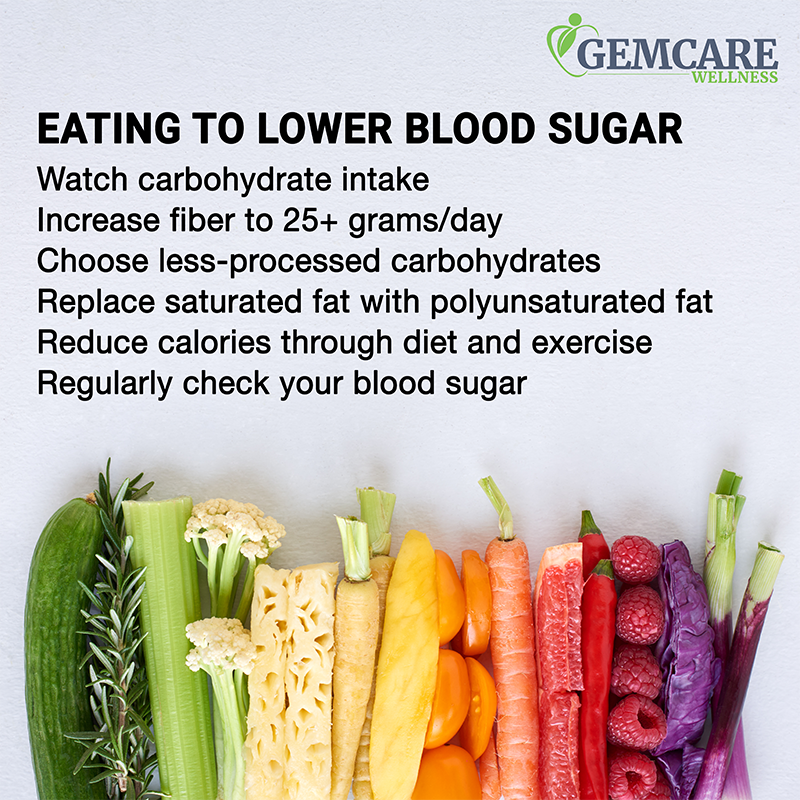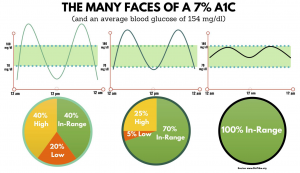Tag: A1C
November 23, 2020
Start 2021 the Right Way – By Taking Charge of your Health!
Written by Dana Onesti, RD, LD and Kayla Bechtel, RD, LDN, CPT
Do you have the same New Year’s Resolution each year only to lose sight of it come February? With less than 8% of people achieving their resolutions, make a change to avoid type 2 diabetes and ensure you don’t fall in this statistic!1
Enroll in the GemCare Wellness Diabetes Prevention Program (DPP) to make certain this will be the “New Year, New You” that you have always wanted. While many fad diets and promises of a “quick fix” bombard your newsfeed, the DPP classes are built on a lifestyle change program. This free, year-long program – funded by the Ohio Department of Health – focuses on long-term changes and results that will last! During your journey, you will work alongside Registered Dietitians (RDs) who will provide you with the tools and knowledge to succeed. Furthermore, you will have the accountability and support of other like-minded individuals who are working toward similar goals.
Past and current participants of this program have cut their risk of developing type two diabetes by 58%.2 To do this, they lost 5-7% of their body weight and exercised at least 150 minutes of moderate-intensity activity per week. Each class, your dietitians will educate you on a new topic, diving deeper into nutrition and exercise. Some of the classes include topics such as the struggle of lifestyle change, stress management, tactics to stay motivated, food preparation, preventing a relapse, and many more.
For the first 6 months, classes meet on a weekly/biweekly basis. This provides the essential accountability needed for long-term success. For the last 6 months, the group meets monthly to tackle any new challenges and ensure your progress is still going strong. As a virtual program, it could not be easier to join from your home while achieving your goals!
Two years ago my glucose numbers started to creep up, and I was overweight for my body structure. This class class helped me to understand lifestyle changes in both diet and physical activity. Learning to limit carbs and moderately exercising 20 to 30 minutes a day has really changed me. – 2019 DPP Participant
Don’t let another year pass by! Make the commitment to your physical and mental health; let our team help you feel your best while reducing your risk of type 2 diabetes! Click the link below to get started.

References:
- UAM Medicine. (2019). 10 Secrets of People Who Keep Their New Year’s Resolutions. Retrieved from https://www.uabmedicine.org/-/10-secrets-of-people-who-keep-their-new-year-s-resolutions#:~:text=Less%20than%208%25%20of%20people,about%20sticking%20to%20your%20goals.
- Centers for Disease Control and Prevention. (2018, November 15). About the National DPP. Retrieved from https://libguides.massgeneral.org/c.php?g=679228&p=4982801
November 17, 2020
Eating to lower blood sugar for type 2 diabetes
November is American Diabetes Month, which is a time to take action together to raise awareness and draw attention to the importance of proper diabetes education. Learn more at www.diabetes.org.
 “You don’t realize how bad your body feels until you change something. I feel so much better now and that was worth it.”
“You don’t realize how bad your body feels until you change something. I feel so much better now and that was worth it.”
When we think about treating diabetes, the first thing that usually comes to mind is insulin injections or staring down a pillbox. But instead of looking into the medicine cabinet, is there a way we can take a glance in our fridge and manage type 2 diabetes? Yes! As the Greek physician, Hippocrates said, “Let food be thy medicine and let medicine be thy food.”
Type 2 diabetes occurs when the body doesn’t respond to insulin. Think of insulin as a key that unlocks the door to let sugar or glucose into your cells. When the key is not working, then the extra glucose floats around in our bloodstream and we get high blood sugar readings.
Why does this happen? Exactly why is unknown, but we do know our genes and lifestyles (including being overweight and/or inactive) influence it. We can’t really mess with our genes. We have to deal with the deck of cards we are dealt, BUT we can control lifestyle choices.
So, the million-dollar question: What is the diet I need to be following to positively affect type 2 diabetes? Is it high fat? Is it low carb? How does the nutrition community feel about keto nowadays?
The answer – and to be honest, you may not like it – isn’t simple and you need to look at what YOUR body says. Doing your research and gathering data is the best way to answer this question. Working on small lifestyle changes can make the body more sensitive to insulin.
Even though it’s the holiday season, there’s no reason to wait to get started. The following strategies can help you start making positive changes NOW:
- Watch your carbohydrate intake – there are lots of free apps that can help you track daily intake.
- Increase your fiber to at least 25 grams per day – think leafy greens, broccoli, cauliflower, and beans.
- Choose less-processed carbohydrates over highly processed carbs – an apple a day keeps the doctor a day, not an apple juice box a day!
- When possible replace saturated fats with polyunsaturated fats – think less fat from protein (meat) and more from plants (like avocados).
- Watch how a high-fat meal affects blood sugar – high-fat meals may delay the breakdown of food and blood sugar spike, and also increase insulin requirements.
- Lower your calorie intake, either through food or increasing movement – this helps the body use the glucose better and tends to lower blood sugars.
- Regularly check your blood sugar to make sure it is in range and to identify how your diet and exercise impact the numbers.
But what benefit do you get out of focusing on how to eat? Some numbers are lower on a glucose meter, so what? Our clients tell us every day why making good choices is important! One client was diagnosed with type 2 diabetes and started checking his blood sugar per doctor’s orders. He could not seem to get it below 200 mg/dL, which is a high reading. We focused on making small changes like eating smaller portions, eating out one day less in a week, and giving up bread. He recently told us that his blood sugar no longer goes above 140 mg/dL, a reading well within range! He also said, “You know, you don’t realize how bad your body feels until you change something. I feel so much better now and that was worth it.”
Another client really struggled with adjusting his NPH insulin. Because this is a fixed dose of rapid and background insulin, the client must eat the same amount of carbohydrates at around the same time per day. In the summer this was a hard routine to follow. A lot was going on, this client’s weight had gotten to his highest point, and he was taking around 38 units of insulin twice a day. Sometimes at night, he would go so low that he would have to use glucose tabs. With trial and error and working with his Registered Dietitian, he tested what foods worked for him. He decided on a lower-carbohydrate meal pattern. Each day, he planned for 2 proteins, 2 servings of fruit, 3 servings of veggies, and 2 servings of carbs. Through focusing on this lower-carb, balanced approach for three months, he is down 20 pounds and is only using 18 units of insulin a day!
Lifestyle choices allow us to be in charge of type 2 diabetes. Nutrition is a way to feel better, lower blood sugar levels, lose weight, and possibly reduce medication needs. If you’d like extra help with meal planning or have questions related to type 2 diabetes, feel free to reach out to contact us today to set up a consultation!
If you have not been diagnosed with type 2 diabetes, but have prediabetes or are at risk of prediabetes, check out our virtual Diabetes Prevention Programs. These online programs are sponsored by the Ohio Department of Health and free to participants. Classes start in January, so sign up today: https://www.gemcarewellness.com/programs/diabetes-prevention/
November 10, 2020
What does “time-in-range” have to do with diabetes control?
 November is American Diabetes Month, and today, Nov. 14, 2020 is World Diabetes Day. This is a time to take action together to raise awareness and draw attention to the importance of proper diabetes education. Learn more at www.diabetes.org and www.worlddiabetesday.org.
November is American Diabetes Month, and today, Nov. 14, 2020 is World Diabetes Day. This is a time to take action together to raise awareness and draw attention to the importance of proper diabetes education. Learn more at www.diabetes.org and www.worlddiabetesday.org.
Just when we were all getting familiar with our A1C levels, a fairly new buzz-worthy phrase has emerged in relation to diabetes control, and that’s “time-in-range.” What “range” do the experts mean? According to the American Diabetes Association, it’s your target range for blood glucose (BG) levels and is generally 70 to 180 mg/dl. This includes BG readings before meals and after meals.
If you’re not familiar with time-in-range (TIR) now, you will be soon. As the adoption of continuous glucose monitors (CGM) continues to increase, you’ll see more people talking about TIR. The only way to accurately measure TIR is by continuously monitoring your blood glucose with a CGM, which will show you the history of your BG, not just a snapshot in time like a fingerstick measures. This information helps you identify trends and manage your diabetes more confidently.
Now that we know the target range is 70 to 180 mg/dl, the next step is to determine at what percentage of the day should you be within this range. What is a reasonable percentage? Should it be 100% of the time? Should it be 90% of the time?
Ultimately the answer depends on where you’re starting. For example, if you are in the range 50% of the time, then aim 60% of the time. Also, know that your medication regimen may also make achieving a high percent more challenging, and you and your healthcare team may choose a lower TIR goal. Managing diabetes is always individualized, and identifying TIR goals is no different.
And that achieving that TIR goal isn’t your only objective. Let’s say that you have a 90% TIR, which sounds great, right? But if the other 10% of the time your blood sugar is less than 70, you run the risk of hypoglycemic episodes that could be dangerous and should be avoided. Your goal, then, would be to work on avoiding the lows, even if it means that your percent time in range is a little lower, especially at first. Ideally, you want your time below 70 to be no greater than 3%. If you are having BG less than 70 more often than 3% of the time, it is likely time to reduce a medication that can cause lows.
As people with diabetes will know, most doctors judge your degree of blood sugar control on your A1C, which is based on the average blood sugar level over a three-month period. If you are using a CGM, you may wonder which is more important, TIR or A1C?
A1C has a well-known relationship with the risk of complications. Risks for things like kidney issues, eye problems, vascular, and nerve problems increase as the A1C goes up. But the problem with A1C is that it is an average of your blood sugar! You might be averaging very high numbers with very low numbers. These swings in blood sugar are not healthy.
Consider the chart below from DiaTribe. It shows the limitations of only looking at A1C results. As you can see, each graphic shows a different time-in-range, but they all have the same A1C of 7.0% (an average BG of 154mg/dl). Because we want to limit highs and slows, the third graphic with a 100% TIR is optimal.

CGM users are finding that they are empowered when knowing their BG levels immediately. With the advent of the CGM, waiting three months to find out how you’re doing is no longer status quo. At GemCare Wellness, we work with many people who have diabetes and use CGM along with health coaching from us to help manage their condition:
Gloria P. has recently said that she is now aware of the “evil carbs.” The CGM helped her recognize that “all carbs are not created equal” and that certain carbs impacted her blood sugar more than others. Since then, she has tried to limit use of rice, apples, and corn because they act as “bad carbs” for her, even in small portions.
Jason M. found that he could lower his medication use now that he has the CGM. By being aware of the changes in his blood glucose levels, he changed his diet and added exercise when his blood sugar was on the rise. He’s now reduced his medications in half, has better control, and is even saving money with lower medication costs! He reports that “all is good! I am saving money on meds and improving my lifestyle.”
Both of these individuals have successfully improved their time-in-range and now are awaiting that three-month A1C check. Hopefully, that number will make them proud — we’re already proud of them for all the work they’ve done to improve their health.
If you’re interested in working with GemCare Wellness, please contact us today to set up a consultation! Whether you’re an individual looking to improve your health or an employer focused on a healthier population, GemCare Wellness has a program to fit your needs!

November 4, 2020
Take Charge of Your Health This Holiday Season with GemCare Wellness’ Diabetes Prevention Program
Written by Jenna Adams, MFN, RD, LD & Heather Fowler, RDN, LD
Want to get a jumpstart on your health before the new year sets in? Want to learn how to manage your health during the holidays while still being able to enjoy your favorite seasonal foods? Food is a big part of the holidays, and it can be challenging to stay on track, but GemCare Wellness’ Diabetes Prevention Program (DPP) can help you learn and implement lasting lifestyle changes to improve your health and delay or prevent type 2 diabetes.
Our free-of-charge*, virtual Diabetes Prevention Program is open to anyone who has been diagnosed with prediabetes or who is at risk for developing type 2 diabetes (T2). Losing 5-7% of your body weight and getting at least 150 minutes of physical activity each week can lower your risk for developing type 2 diabetes by 58%, and if you are 60 or older, you can lower your risk by 71%.1
DPP classes provide you with knowledge and tools to navigate not only the holidays but each day successfully. You’ll learn how to incorporate the tools you learn in this program into lifelong, lasting change. Here are a few tips to get you started:
- Have a light meal or snack before a holiday event to help control your appetite.
- Bring a healthy option, such as a veggie or fruit tray.
- Hold a glass of water to stay hydrated and prevent grazing.
- Scope out the selections at family meals and prioritize your favorites, forgoing those you could do without.
- Select a moderate portion of the dessert that appeals most to you.
- Plan for fun family activities indoors or outdoors, such as going for a walk, playing board games, or having a snowball fight.
Topics we will cover throughout the year include how to eat to prevent type 2 diabetes, shop and cook, manage stress, take charge of your thoughts, and stay motivated. With weekly classes in the first sixth months of the program, you’ll find the needed support to help you navigate the holiday season. Join now, end the year strong, and start 2021 one step closer to your health and wellness goals!

*Program free of charge to participants. Funded by the Ohio Department of Health.
Sources:
- “About Prediabetes & Type 2 Diabetes.” National Diabetes Prevention Program, Centers for Disease Control and Prevention, Apr. 2019, cdc.gov/diabetes/prevention/about-prediabetes.html.
October 19, 2020
Achieving Results with GemCare Wellness’ Diabetes Prevention Program
Written by Emily Topp, MS, RDN, LD
“I’ve seen numbers on the scale that I haven’t seen in years thanks to the GemCare Wellness Diabetes Prevention Program!” – 2019 DPP Participant
Did you know that 1 out of every 3 American adults has prediabetes? Additionally, of those with prediabetes, more than 8 out of 10 of them don’t even know that they have it. If those with prediabetes do not take action, they run the risk of developing type 2 diabetes within 5 years.1
COULD THIS BE YOU?
GemCare Wellness is delivering a Free, Virtual Diabetes Prevention Program (DPP) to assist participants in achieving their personal health goals, along with reducing their risk of developing type 2 diabetes. The overall goal of the DPP is for participants to lose 5% of their starting body weight and to average at least 150 minutes of physical activity per week. For high-risk individuals, achieving these goals reduces their chance of developing type 2 diabetes by 58%. Since 2017, class participants have exceeded these goals and lost more than 6.4% of their starting body weight while averaging over 200 minutes of physical activity per week!
This year-long, evidence-based intervention program is no-charge* and open to anyone who has been diagnosed with prediabetes or those who may be at risk for developing type 2 diabetes. Our classes provide participants with the tools to make lifestyle changes, including dietary improvements and an increase in physical activity, along with a support group that includes individuals with similar goals and challenges. Our Registered Dietitians are dedicated to helping participants make positive, long-lasting changes, one step at a time.
Are you at risk? Take our Prediabetes Risk Test today!

WHAT MAKES OUR PROGRAM UNIQUE?
While most DPPs use health coaches to teach their sessions, our program is led by a team of Registered, Licensed Dietitians who are healthcare experts. They will be available to you during and between classes to answer any questions you may have!
All classes are virtual, making it easy to join from the comfort of your own home! To secure your spot and begin your journey to better health, click below.

*Program free of charge to participants. Funded by the Ohio Department of Health.
Sources:
- “About Prediabetes & Type 2 Diabetes.” National Diabetes Prevention Program, Centers for Disease Control and Prevention, Apr. 2019, www.cdc.gov/diabetes/prevention/about-prediabetes.html.






